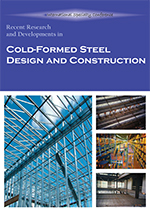Session Dates
24 Aug 2012 - 25 Aug 2012
Keywords and Phrases
portal frame, cold-formed steel, optimization, genetic algorithm
Abstract
The design optimization of cold-formed steel portal frame buildings is considered in this paper. The objective function is based on the cost of the members for the main frame and secondary members (i.e., purlins, girts, and cladding for walls and roofs) per unit area on the plan of the building. A realcoded niching genetic algorithm is used to minimize the cost of the frame and secondary members that are designed on the basis of ultimate limit state. It is shown that the proposed algorithm shows effective and robust capacity in generating the optimal solution, owing to the population’s diversity being maintained by applying the niching method. In the optimal design, the cost of purlins and side rails are shown to account for 25% of the total cost; the main frame members account for 27% of the total cost; claddings for the walls and roofs accounted for 48% of the total cost.
Department(s)
Civil, Architectural and Environmental Engineering
Research Center/Lab(s)
Wei-Wen Yu Center for Cold-Formed Steel Structures
Meeting Name
21st International Specialty Conference on Cold-Formed Steel Structures
Publisher
Missouri University of Science and Technology
Document Version
Final Version
Rights
© 2012 Missouri University of Science and Technology, All rights reserved.
Document Type
Article - Conference proceedings
File Type
text
Language
English
Recommended Citation
Phan, Duoc T.; Lim, James B. P.; Tanyimboh, Tiku T.; and Sha, Wei, "Advanced Design Optimization of Cold-formed Steel Portal Frame Buildings" (2012). CCFSS Proceedings of International Specialty Conference on Cold-Formed Steel Structures (1971 - 2018). 2.
https://scholarsmine.mst.edu/isccss/21iccfss/21iccfss-session8/2
Advanced Design Optimization of Cold-formed Steel Portal Frame Buildings
The design optimization of cold-formed steel portal frame buildings is considered in this paper. The objective function is based on the cost of the members for the main frame and secondary members (i.e., purlins, girts, and cladding for walls and roofs) per unit area on the plan of the building. A realcoded niching genetic algorithm is used to minimize the cost of the frame and secondary members that are designed on the basis of ultimate limit state. It is shown that the proposed algorithm shows effective and robust capacity in generating the optimal solution, owing to the population’s diversity being maintained by applying the niching method. In the optimal design, the cost of purlins and side rails are shown to account for 25% of the total cost; the main frame members account for 27% of the total cost; claddings for the walls and roofs accounted for 48% of the total cost.



